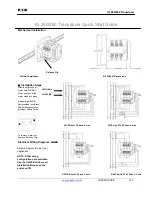
Air2-BS200 | © 2020 Inim Electronics S.r.l.
13
5.2 Transceiver parameters
the transceiver model
the firmware version of the transceiver board
the transceiver parameters
a list of devices enrolled by the transceiver;
for each device it shows:
the Icon
the terminals (where present)
the serial number
the model
5.2 Transceiver parameters
The programming software, selecting a transceiver, sets the following functions and parameters:
Clone remote-con-
trol keys
This function starts the guided cloning process of the wireless keys enrolled via the transceiver of the selec-
ted reader.
The guide allows you to indicate which transceiver, from those selectable, the cloned keys will be assigned
to.
RF
This function starts an operation which attenuates (6db) the wireless signal transmitted by the transceivers
for 5 approximately minutes.
During this period the installer can carry out tests on the stability of the RF connection under weak-signal
conditions.
Channel
Section for the selection of the wireless communication channel used by the transceiver that simulates the
reader that is undergoing programming:
Channel 001,868.1 MHz
Channel 002,868.3 MHz
Channel 003,868.5 MHz
Disable tamper pro-
tection
This option disables the tamper signal of the transceiver.Air2-BS200.
Disable the Rolling
Code
This option disables the use of a rolling-code algorithm for the transmission of wireless commands via the
moduleAir2-BS200.
Deactivation can be useful to the installer when the same wireless command device is used on several sys-
tems.
5.3 Programming from Air2-BS200
Programming from a module Air2-BS200 allows you to set only some of the system programming para-
meters Air2 and only when used with a SmartLiving system.
This programming also includes a specific section for the addressing of the Air2-BS200, available for both
SmartLiving and Prime control panels.
The available programming phases correspond to the 6 different sections in the Programming menu. Use
the buttons and LEDs on the PCB of the module to navigate through the 6 programming phases.
1. Press the
P1
button.
The programming menu will open.
2. Press the button again until access to the required phase is achieved. LED DL3 will emit a number of
blinks corresponding to the current phase.
3. Using the
P2
button carry out any changes (where required). Where required, LED DL4 will show the
current data.
4. Save any changes and exit the programming session.
This can be done in two ways:






































